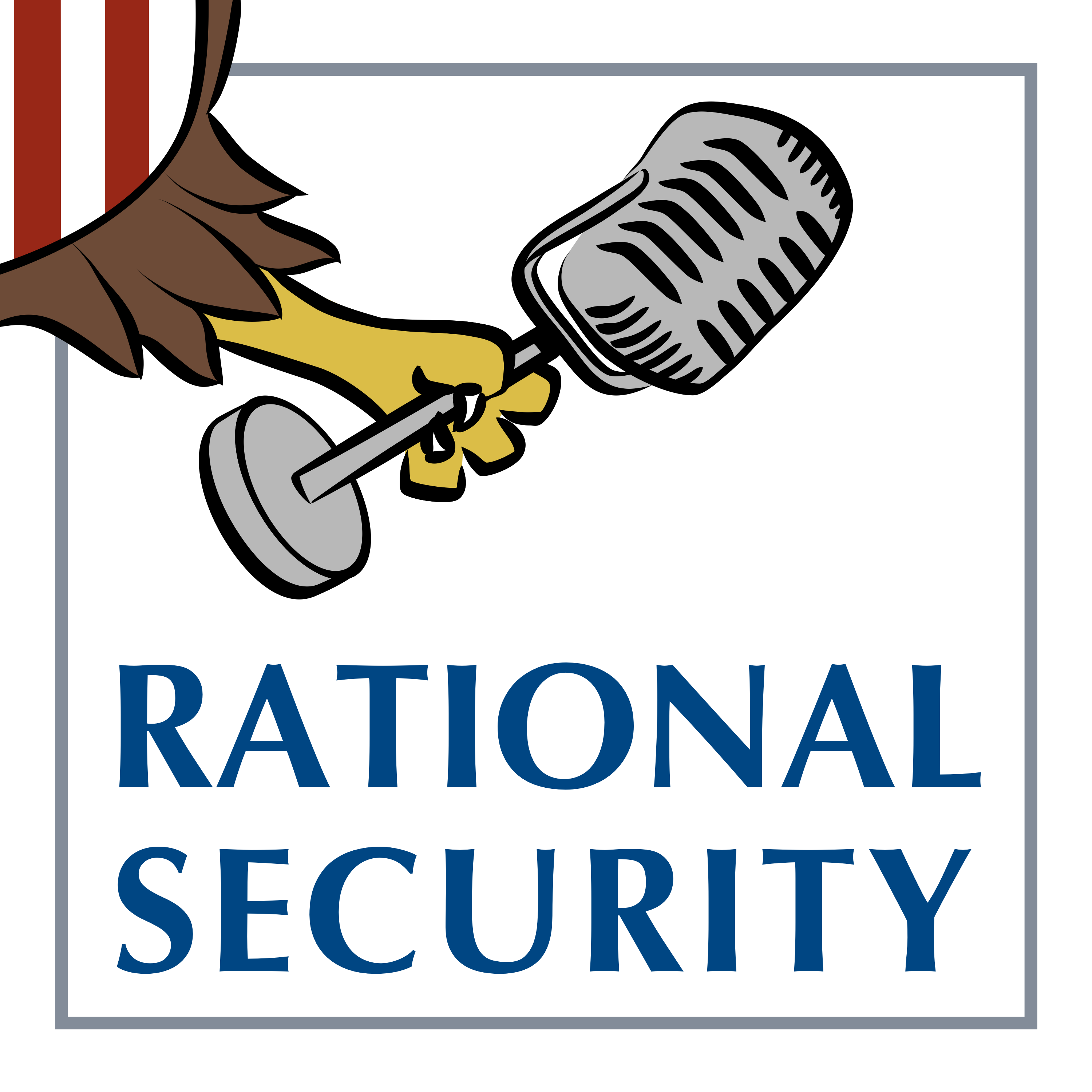For First Time, Most Americans Want to Back Ukraine for ‘as Long as It Takes’
Plus a few other takeaways from a recent poll on Americans’ support for Ukraine, ahead of the Trump-Putin meeting
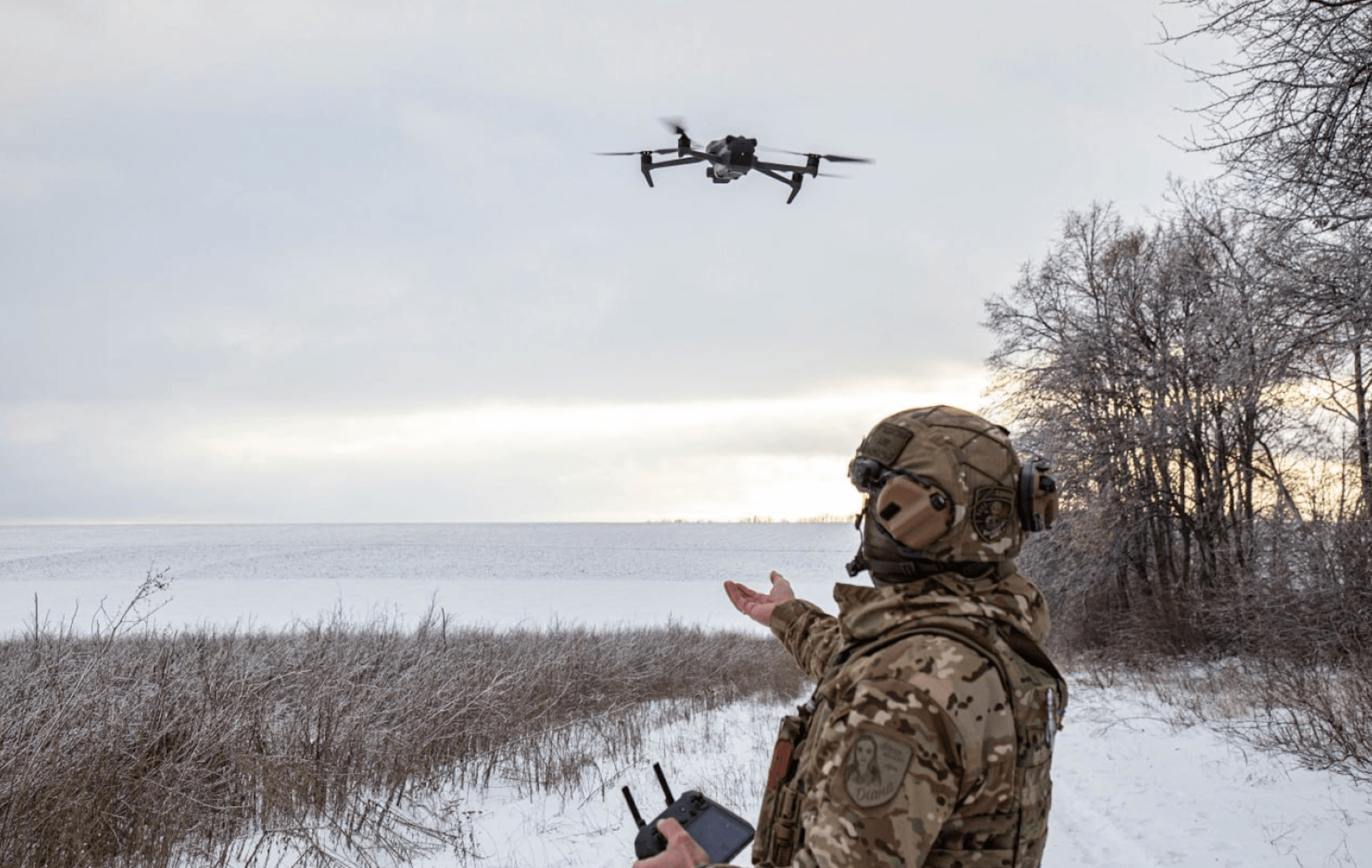
Published by The Lawfare Institute
in Cooperation With

As President Donald Trump prepares to meet Russia’s President Vladimir Putin in Alaska, America’s western allies have raised concerns that the U.S. president may agree to terms that are not favorable to Ukraine—especially in Kyiv’s absence.
These concerns heightened further after Trump declared, “There’ll be some swapping of territories to the betterment of both.” Canadian Prime Minister Mark Carney phoned Ukrainian President Volodymyr Zelenskyy to assure him that Canada remains adamant in its support of Ukraine’s sovereign decisions about its own territory, and German Chancellor Friedrich Merz organized an emergency virtual summit between European leaders, Zelenskyy, and Trump to try to provide some coordination ahead of Friday’s summit.
European and Canadian leaders’ support of Ukraine has remained steadfast in the face of Trump’s talk of ending the war with Ukraine quickly with territorial concessions and his often-expressed criticism of Ukraine’s leadership. But what about support for Ukraine among the American public? To what extent are the American people prepared to continue to back Ukraine in the war with Russia? And what are the implications for the Trump administration’s foreign policy?
To better track the degree of American support for Ukraine, the University of Maryland Critical Issues Poll fielded questions with SSRS among a sample of 1,514 Americans over the age of 18 from their online panel from July 29 to Aug. 7. The margin of error is +/- 2.9 percent.
The poll found that support for Ukraine among the American public is at its highest since early 2023. Here are three key takeaways from the poll and an analysis of their potential implications for Trump’s foreign policy.
First, Americans remain overwhelmingly more sympathetic to Ukraine than to Russia, with a marked increase in sympathy Republicans feel toward Ukraine since March.
Nearly two-thirds of Americans polled, 64 percent, say they sympathize more with Ukraine compared to two percent who say they sympathize more with Russia. This support for Ukraine constitutes an increase of five percent from 59 percent the last time we conducted a similar poll in March 2025. Notably, most of the increase came from Republicans whose sympathy went up from 45 percent in March of 2025 to 55 percent in the latest poll, while Democratic support remains nearly the same at 83 percent compared to 82 percent in March 2025. Sympathy with Russia has remained nearly non-existent at 2 percent—a constant since July 2024—with practically no Democrats sympathizing more with Russia and only 3 percent of Republicans saying the same.
.png?sfvrsn=fec81079_3)
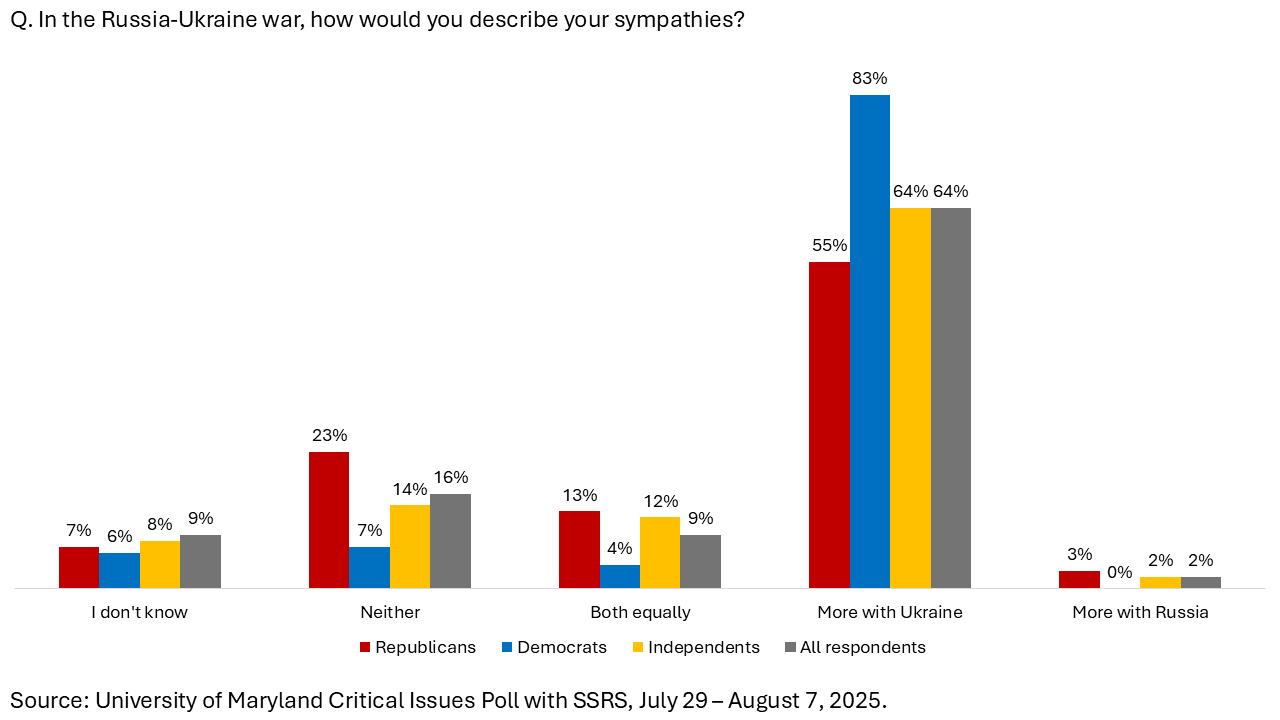
Second, for the first time since we started asking this question in March 2023, a majority of Americans say the United States should stay the course in supporting Ukraine “for as long as it takes.”
Overall, 54 percent of respondents said the U.S. should stay the course for as long as it takes, compared to 48 percent in July and August 2024, 45 percent in September and October 2023, 43 percent in June 2023, and 38 percent in March and April 2023. (Note that we also asked this question in March 2025, but only of those who said “oppose” or “I don’t know” to the question: “Do you support or oppose the decision?” This subset represented roughly 44 percent of all respondents). This question had an unsurprising partisan divide, with much of the rise in support coming from Democrats, with 74 percent of respondents from that party saying they want to stay the course “as long as it takes,” compared to 63 percent a year ago. Only 36 percent of Republicans said the same, compared to 37 percent a year ago.
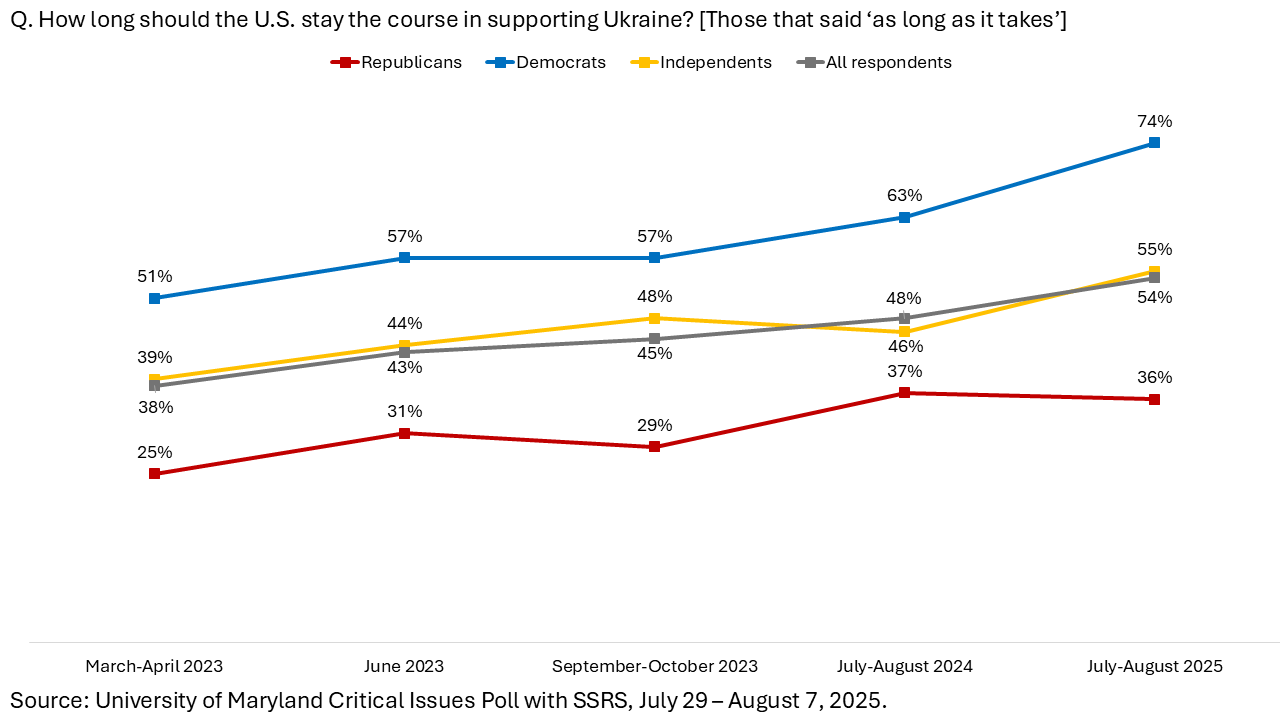
In addition, 23 percent of all respondents said that backing Ukraine should stop immediately, including 35 percent of Republicans, 10 percent of Democrats, and 24 percent of independents; 15 percent overall said support should be maintained for one to two years, 6 percent said two to five years, and one percent said five to 10 years.
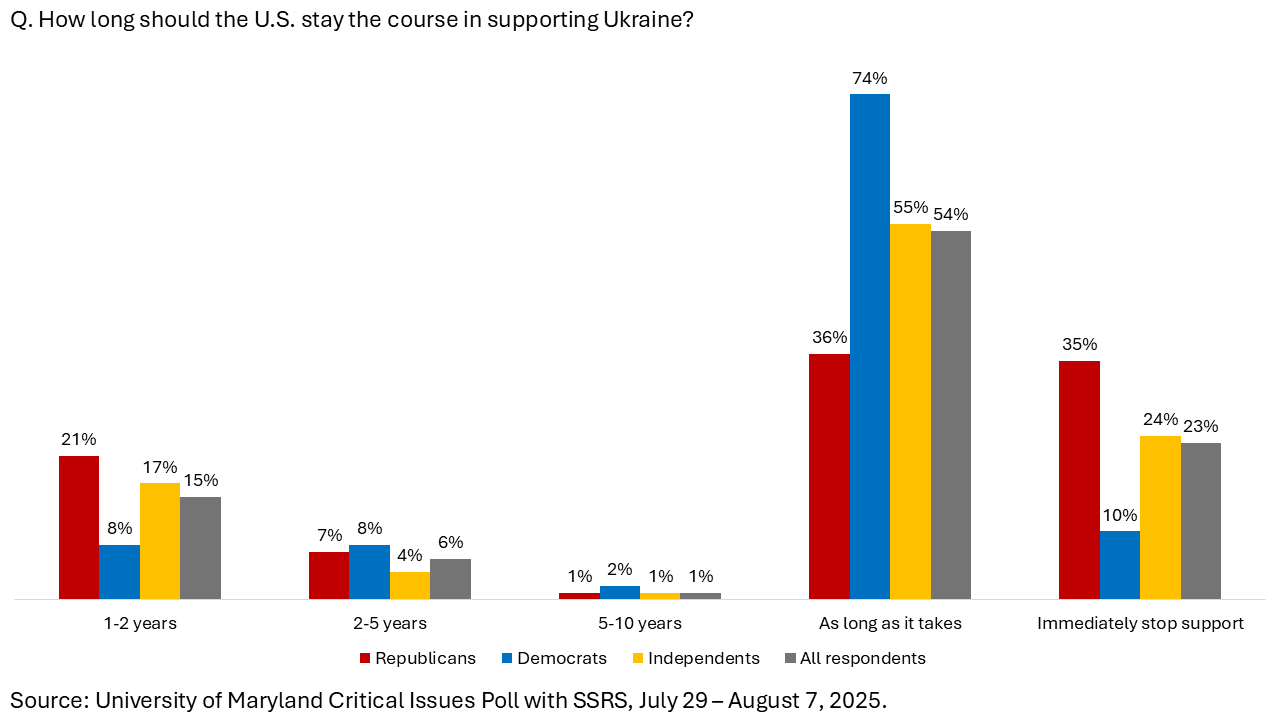
Third, the poll found that Americans identify Putin as the greatest threat to world peace and security and Trump as the second greatest threat.
In an open-ended question asking respondents to list the three U.S. and world leaders they feel pose the greatest threat to world peace and security, Americans polled most frequently identified Putin on their list, followed by Trump, then North Korea’s Kim Jong un, China’s Xi Jinping, and Israel’s Benjamin Netanyahu. While Republicans identified most frequently Putin, followed by Xi Jinping, Democrats identified Trump first, followed closely by Putin. It is notable that for Republicans, Trump was the fifth most frequently mentioned leader as threatening world peace and security.
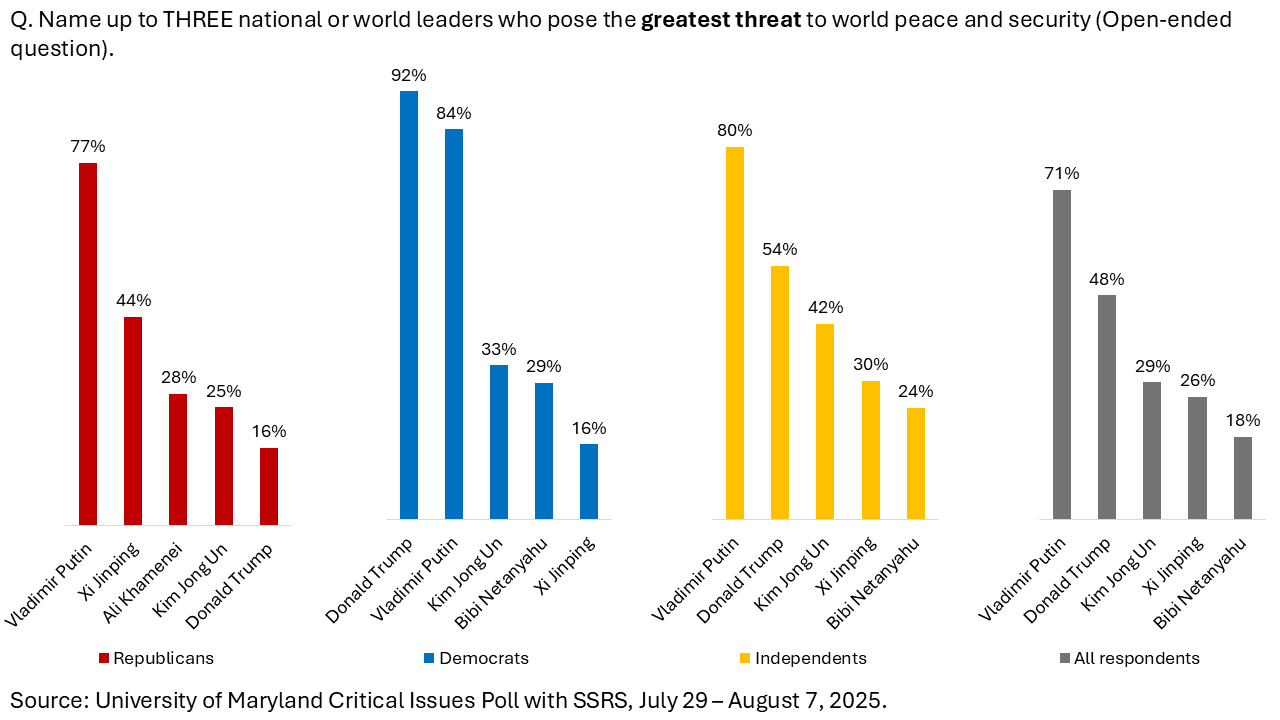
Implications
The recent poll suggests that President Trump’s impact on American public attitudes toward the Ukraine-Russia war has been limited, including on Republicans, as our opinion tracking since 2023 has shown. But given the huge gap in sympathy for Ukraine compared to sympathy for Russia among Republicans (55 percent to 2 percent), one might expect more public pressure on Trump to shift course more than he has. One of our previous studies, which directly followed President Trump’s stormy meeting at the White House with President Zelenskyy on Feb. 28, showed that more Americans seemed to sympathize with Zelenskyy than with President Trump on that issue, while American support for Ukraine remained robust after that meeting. However, the February poll should be interpreted in the context of a honeymoon period for the new Trump administration, during which Republican enthusiasm remained strong. Our polling suggests that Trump seemed to have some impact on Republican attitudes at the time, with Republican sympathies for Ukraine dropping from 58 percent in August 2024 to 45 percent in March 2025—still considerable, especially if one takes into account that this drop did not translate into more Republican sympathy for Russia, which remained relatively constant at 5 percent.
Despite this gap between Trump’s own public posture on Russia and Ukraine and toward Putin and Zelenskyy, his approval ratings among Republicans have not suffered, even as they have dropped among Americans overall. To be sure, Trump moved to modify his stance at least modestly after the February meeting, perhaps sensing the discomfort of his base. He was far more positive toward Zelenskyy after their meeting in Rome in April at Pope Francis's funeral, and Trump became more critical of Putin than in the past, even threatening sanctions on Russia. And he moved quickly after the backlash that followed the Pentagon’s suspension of delivery of certain arms to Ukraine, reversing the decision. That brings us to this week’s Alaska summit, which excludes Zelenskyy, accompanied by suggestions that Trump supports Russian control of parts of the occupied Ukrainian territories.
Our latest poll shows that American support for Ukraine has increased since March, including, surprisingly, the level of sympathy for Ukraine among Republicans. It is also notable that, as the president is set to meet Putin without Zelenskyy’s participation, a new Gallup poll showed that Zelenskyy’s net favorability with Americans is considerably higher than Trump’s, coming second only to Pope Leo on a list of 14 leaders. Trump’s position near the bottom of that list adds further context to our own poll findings on the American public’s views of Putin and Trump as two of the top threats to world peace and security.
One finding potentially working against long-term support for Ukraine is that young people (ages 18-34) across the partisan divide are somewhat less sympathetic toward Ukraine (53 percent compared to 69 percent of those 35 and older), though this lower level of support for Ukraine does not translate into more sympathy for Russia. They are also less likely to back U.S. support for Ukraine for “as long as it takes” (50 percent compared with 56 percent of those 35 and older). The gap on this issue is even wider among Republicans: 27 percent of Republicans under 35 back staying the course as long as it takes, compared to 38 percent of those 35 or older.
As Trump seeks a deal with Putin to end the war, he may find himself at odds with Western allies and the American public who view Putin with suspicion and overwhelmingly sympathize with Ukraine over Russia.


